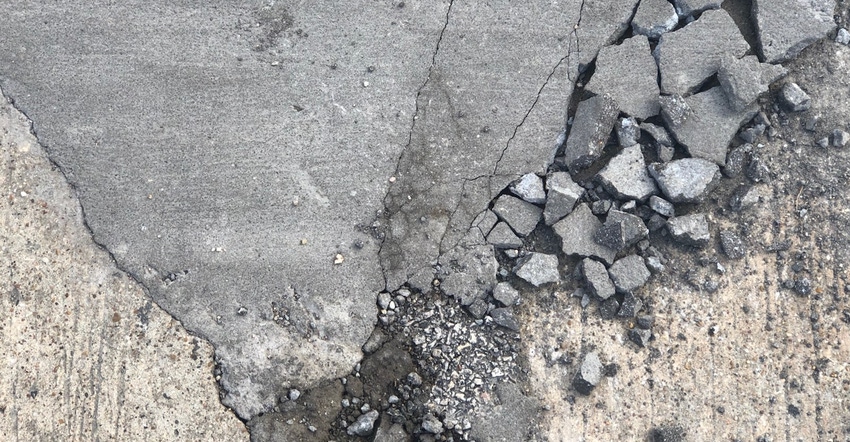Repairing Distressed Asphalt Surfaces for the Long Run
A new technology chemically bonds cementitious repair mortar to the asphalt’s bitumen for a fast, permanent and cost-effective repair or patch.

Concrete professionals promote that all roads should be paved with concrete for a durable, long life. But since many jurisdictions still specify the use of asphalt, concrete material researchers have been developing durable repair solutions to extend an asphalt pavement’s service life when it fails. One example of the concrete industry’s help is the recently updated concrete overlay guide, designed to cover up large sections of asphalt pavement.
But what should owners, specifiers and contractors do when tasked to repair smaller asphalt areas such as utility cutouts and potholes? Using common concrete repair products on small areas often results in mixed performances. Creating a durable bond between concrete and asphalt, or even asphalt to asphalt, can be difficult.
But now researchers from the concrete industry have introduced a new solution for these small repairs. Paul Sampson, co-owner of K&S Materials, has patented a cement technology that approaches pavement repairs with a new yet familiar approach.
For the last two years, Sampson’s team has been focusing this technology to develop a product aimed at one of road repair’s most challenging tasks—repairing potholes in asphalt pavements. This unique product has been proven in field tests to provide durable repairs. Not only is the repair permanent, but contractors also can accomplish the task with a lot less prep and installation time.
From bomb holes to potholes
Sampson has spent a great amount of his professional life developing solutions to repair concrete pavements and other structural elements with cementitious materials. He has helped manufacturers develop a number of cement-based repair products for contractors that successfully use them to repair concrete surfaces.
A notable part of Sampson’s career involved working on projects with the U.S. Army Corps of Engineers to develop rapid repair solutions for bombed runways and the U.S. Marine Corps for IED mitigation on convoy routes. “We were tasked to develop a simple solution that returned runways to service as fast as possible with a repair material that could prevent damaged roads from having explosives hidden in them, hardened rapidly at ground temperatures approaching 130°F, and provided adequate working time to use common placement procedures,” said Sampson.
In recent years, Sampson has focused his research on solving the challenge of repairing streets, highways and pavements. X-PHALT, the initial product that K&S Materials is bringing to market, is taking on the bane of every transportation owner—extending the service life of pothole repairs.
There are a number of traditional cement-based repair products that can be used for asphalt pavements in lieu of simple cold patch. But these materials require increased preparation practices, primers and mechanical substrate roughening to achieve durability. Thus, these products can be more expensive with little difference in long-term performance when compared to cold patch techniques.
A cost-efficient alternative
Asphalt pavements are typically repaired using either cold patch or hot mix asphalt. Each has its own advantages and disadvantages. Owners often have to balance budgetary concerns with the actual long-term cost of road maintenance for that location. According to the 2021 Current and Future Best Practices for Pothole Repair in Illinois, repairs made with cold mix asphalt are anticipated to perform well for one year, while hot mix asphalt repairs are expected to remain in good condition for three to six years, with great variation.
And just as important is the repair time. When crews use a throw and roll patching technique, traffic disruptions are minimal. Hot mix asphalt repair techniques have longer traffic disruptions due to the need for heavy onsite equipment and larger labor crews.
Sampson says the very initial cost-benefit studies have indicated that X-PHALT technology will be more effective than either traditional asphalt pavement repair. Workers mix the repair material on site, using tools. They then fill the pothole with X-PHALT after the removal of standing water and loose and distressed materials. The freshly mixed material is firm, but easily placed, requiring simple mortar consolidation and finishing techniques to match the pavement’s profile, even on steep grades.
Interacting to increase service life
Sampson’s team has been monitoring test placements for more than two winter seasons. The repairs are still solid with zero instances of de-bonding. Sampson anticipated this result due to his patented technology and application testing.
The repair’s durability is due to the interaction of the bitumen in the asphalt with cementitious materials. “This approach is relatively new, and we have proven its success in the lab and in field tests,” said Sampson.
By its nature, bitumen is hydrophobic and not water soluble. The high molecular weight polar nature of the bitumen is the reason it has an affinity for bonding with aggregates and is waterproof.
Cements are water based. Sampson explains that a water-based material simply is difficult to bond well to a waterproof substrate. This insight caused him to focus his patent on developing a new way of looking at materials.
K&S Materials’ patented technology is based upon the chemical reaction that allows the water-based cement mortar to react directly with the water insoluble carbonyl groups present in the bitumen molecule. This is achieved without the use of solvents, polymers, primers, caustics, acids, etc. The result is a permanent chemical bond between cementitious repair mortar and asphalt pavements.
Make a better repair
Sampson says his product is more than a filler. X-PHALT repair mortars improve the asphalt pavement in these distressed areas. Bitumen has two chemical features that can reduce service life. Thus, asphalt pavements are susceptible to rutting, shoving and raveling.
First, bitumen is a semi-solid at room temperature. It softens as temperature increases and hardens as temperature decreases. And the material behaves as a solid with short mechanical loading times and behaves as a viscous liquid at longer mechanical loading times. X-PHALT has hardened performance qualities akin to cements and concrete. It doesn’t rut, shove or ravel.
Second, there are no polymers present, and it’s not susceptible to UV degradation like bitumen is. This property makes it a much more durable road surface material.
Sampson says X-PHALT can meet or exceed ASTM C928 R3 performance requirements for use as a rapid repair mortar in concrete road repair. It is this durability that is, for the first time, now attainable for asphalt roads as well.
Want to learn more? K&S Materials has developed the X-PHALT Technical Bulletin: Asphalt Pothole Application Recommendation Guide. You can obtain a copy by contacting their technical department.
About the Author(s)
You May Also Like




